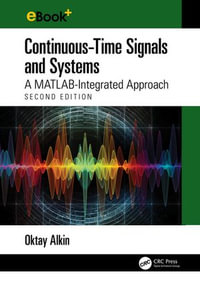
eTEXT
VLSI Synthesis of DSP Kernels
Algorithmic and Architectural Transformations
By: Mahesh Mehendale, Sunil D. Sherlekar
eText | 17 April 2013
At a Glance
eText
$239.00
Instant online reading in your Booktopia eTextbook Library *
Read online on
Not downloadable to your eReader or an app
Why choose an eTextbook?
Instant Access *
Purchase and read your book immediately
Read Aloud
Listen and follow along as Bookshelf reads to you
Study Tools
Built-in study tools like highlights and more
* eTextbooks are not downloadable to your eReader or an app and can be accessed via web browsers only. You must be connected to the internet and have no technical issues with your device or browser that could prevent the eTextbook from operating.
A critical step in the design of a DSP system is to identify for each of its components (DSP kernels) an implementation architecture that provides the desired degree of flexibility/programmability and optimises the area-delay-power parameters. The book covers the entire solution space comprising both hardware multiplier-based and multiplex-less architectures that offer varying degrees of programmability. For each of the implementation styles, several algorithmic and architectural transformations are proposed so as to optimally implement weighted-sum based DSP kernels over the area-display-power space.
VLSI Synthesis of DSP Kernels presents the following:
Six different target implementation styles -
- Programmable DSP-based implementation;
- Programmable processors with no dedicated hardware multiplier;
- Implementation using hardware multiplier(s) and adder(s);
- Distributed Arithmetic (DA)-based implementation;
- Residue Number System (RNS)-based implementation; and
- Multiplier-less implementation (using adders and shifters) for fixed coefficient DSP kernels.
For each of the implementation styles, description and analysis of several algorithmic and architectural transformations aimed at one or more of reduced area, higher performance and low power;
Automated and semi-automated techniques for applying each of these transformations; and
Classification of the transformations based on the properties that they exploit and their encapsulation in a design framework. A methodology that uses the framework to systematically explore the application of these transformations depending on the characteristics of the algorithm and the target implementation style.
VLSI Synthesis of DSP Kernels is essential reading for designers of both hardware- and software-based DSP systems, developers of IP modules for DSP applications, EDA tools developers, researchers and managers interested in getting a comprehensive overview of current trends and future challenges in optimal implementations of DSP kernels. It will also be suitable for graduate students specialising in the area of VLSI Digital Signal Processing.
Read online on
ISBN: 9781475733556
ISBN-10: 1475733550
Published: 17th April 2013
Format: ePUB
Language: English
Publisher: Springer Nature























